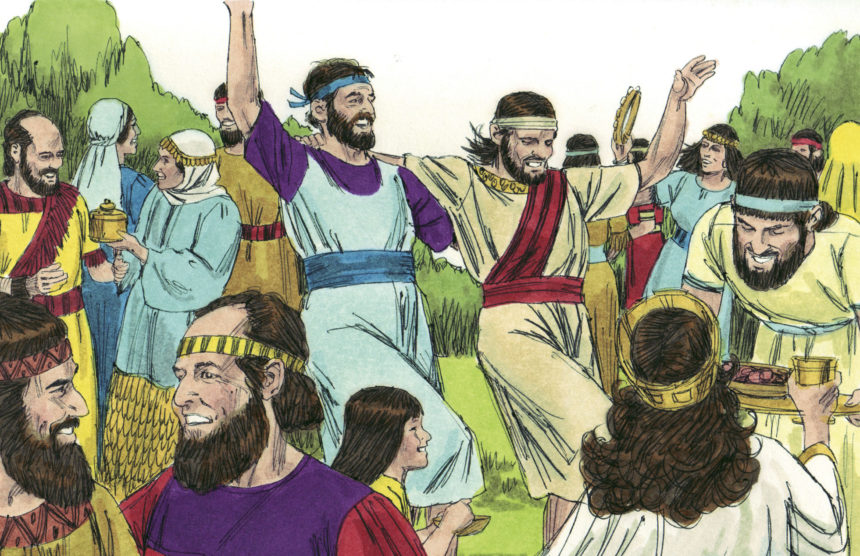Bible Study
Esther Chapters 8-9 (NLT)
Take a moment and consider the place from which Esther has come. She went from a girl who was actively hiding her Jewish identity to a queen who had a hand in very publically creating Jewish customs and rituals. In the modern church, we have taken the opposite route. For much of the last 2000 years, the church has been the foremost creator and disseminator of culture. Some of the greatest compositions ever known originated within the church. Vivaldi was a priest and Handel was a church organist and music director. The church was a great patron of the visual arts as well. Many of the most famous works of Michelangelo like the statue of David and the Sistine Chapel were church commissions. Artists like Rembrandt, Raphael and Titian often utilized religious themes and Biblical stories in their works. Unfortunately, with time the church relinquished its role as cultural creator and these days church musicians, artists, and writers are often viewed as subpar to their secular counterparts. How can we recapture our identity as cultural creators?
Foremost, we must celebrate. The book of Esther ends with Esther and Mordecai creating the annual Festival of Purim which is still commemorated by Jews today. Every year during the Festival of Purim, Jews from around the world celebrate the sweetness of life. They read the story of Esther. They dress in costumes. They drink wine and eat sweet treats. They exchange gifts with each other and give gifts to the poor. Given the amount of banquets in the book of Esther, it should come as no surprise that they also eat copious amounts of food. Esther and Mordecai have moved from people living on the fringes who are afraid to declare their background to people who occupy the very center of power. They are no longer cultural compromisers. They are cultural creators – writing laws, making important decisions, instituting holidays and times of national celebration.
The story of Esther reminds us that even if we cannot see God working, God is still present and active. Even though God is not mentioned by name, he is literally written into the story with acronyms throughout the book (5:4, 5:13, 6:1, 6:14, 7:5). He is omnipresent – in the palace of King Xerxes, in the countryside, in the city, in the nightclub, in the schoolhouse, in the halls of political power and every other place. Even if people refuse to acknowledge his presence, it does not diminish his power or negate that divine presence. God is everywhere and because God is everywhere, we can be confident that God continues to inhabit those places where he is ignored, belittled, or pushed aside. We simply cannot be in a place or situation where God is not. Moving from cultural compromise to cultural creation is positioning ourselves to recognize and respond to God who is already present and active. Discerning God’s will, God’s mission, and being able to respond that is reason for celebration.
There is also reason for sorrow. With the telling and retelling of Esther’s story, we often forget or omit, the price that was paid. Yes, there was great joy and celebration for the Jews, but there was also massive slaughter. Within the fortress of Susa 800 men died and 75,000 were killed from the surrounding countryside (8:6, 15-16). Change, even positive change, always comes at a price. For the Jews, Esther’s story is about salvation and victory; however, for others this was a story of heartache, fear, and death. It is important to understand that change rarely results in a “win-win” situation. For instance, to accept Jesus Christ as Lord and Savior, one must turn away from sinful attitudes and behaviors. Sure, eternal life is to be gained, but only by surrendering control of our earthly life to God. Jesus warned, “If you try to hang on to your life, you will lose it. But if you give up your life for my sake, you will save it” (Luke 9:24). When we work for change in our world, we must do so with eyes open to the cost and impact of those changes. Cultural creation is an opportunity to practice incarnational empathy, to occupy the sorrow of someone else and to find ways to recognize what was lost.
We don’t know if the church will ever again find itself on the cutting edge of culture; however, it is good and fitting for Christians to celebrate what God has done in their lives and continues to do. It also good and fitting for Christians to mourn injustice and pain. Paul advises the Romans, “Be happy with those who are happy, and weep with those who weep” (Romans 12:15 NLT). Like Esther, God might have placed us in this place at this time to do just that.
QUESTIONS:
- What should we mourn as a church? Are there sins or wrongs that need public confession and mourning? How do you think it would be appropriate to “mourn” in a public setting?
- What of God’s goodness and providence can we celebrate? How? What is your faith community celebrating? How is your worship and fellowship a form of celebration?
- Have you seen God working even when others didn’t acknowledge Him? Share a time that will encourage others.

